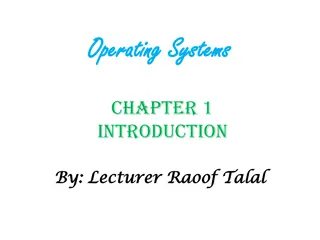Understanding Deadlock in Operating Systems
Deadlock is a critical issue in operating systems where processes are unable to progress due to unfulfilled dependencies. This content explores deadlock scenarios, including traffic deadlock and resource deadlock, and explains the implications within spooling systems. Common deadlock examples and preventive measures are also discussed to enhance system reliability.
Uploaded on Sep 25, 2024 | 0 Views
Download Presentation

Please find below an Image/Link to download the presentation.
The content on the website is provided AS IS for your information and personal use only. It may not be sold, licensed, or shared on other websites without obtaining consent from the author. Download presentation by click this link. If you encounter any issues during the download, it is possible that the publisher has removed the file from their server.
E N D
Presentation Transcript
Dr.Umayal Ramanathan College for Women, Karaikudi Department of Computer Science Operating System 7BCE5C1 Unit III Deadlock and Indefinite Postponement By R.Sivagami Assistant Professor Department of Computer Science,URCW
Introduction Deadlock A process or thread is waiting for a particular event that will not occur System deadlock One or more processes are deadlocked Starvation or Indefinite Postponement - A process that is not deadlocked could wait for an event that might never occur or might occur unpredictably in future. Department of Computer Science,URCW
Examples of Deadlock Deadlocks can develop in many ways. If a process is given the task of waiting for an event to occur, and if the system does not signal that event then we have one process deadlock. In a real system multiple processes competing for multiple resources of multiple types. Department of Computer Science,URCW
1. Traffic Deadlock This kind of deadlock occasionally develop in cities Department of Computer Science,URCW
2. Simple Resource deadlock Most deadlocks develop because of the normal contention for dedicated resources (serially reusable resources, eg. Printer) Circular wait is characteristic of deadlocked systems Holding resources tenaciously in this way, is referred as deadly embrace. Department of Computer Science,URCW
Simple Resource Deadlock Resource deadlock example. This system is deadlocked because each process holds a resource being requested by the other process and neither process is willing to release the resource it holds. Department of Computer Science,URCW
Deadlock in Spooling Systems A spooling system improves system throughput by disassociating a program from slow devices such as printers. Spooling systems are prone to deadlock Common solution Restrain input spoolers so that when the spooling file begins to reach some saturation threshold, the spoolers do not read in more print jobs Today s systems Printing begins before the job is completed so that a full spooling file can be emptied even while a job is still executing Same concept has been applied to streaming audio and video Department of Computer Science,URCW
Example: Dining Philosophers Problem statement: Five philosophers sit around a circular table. Each leads a simple life alternating between thinking and eating spaghetti. In front of each philosopher is a dish of spaghetti that is constantly replenished by a dedicated wait staff. There are exactly five forks on the table, one between each adjacent pair of philosophers. Eating spaghetti (in the most proper manner) requires that a philosopher use both adjacent forks (simultaneously). Develop a concurrent program free of deadlock and indefinite postponement that models the activities of the philosophers. Department of Computer Science,URCW
Example: Dining Philosophers Dining philosopher behavior Constraints: To prevent philosophers from starving: Free of deadlock Free of indefinite postponement Enforce mutual exclusion Two philosophers cannot use the same fork at once Department of Computer Science,URCW
Example: Dining Philosophers The problems of mutual exclusion, deadlock and indefinite postponement lie in the implementation of method eat. Implementation of method eat Department of Computer Science,URCW
Related Problem: Indefinite Postponement Indefinite postponement - Also called indefinite blocking or starvation - Occurs due to biases in a system s resource scheduling policies Aging Technique that prevents indefinite postponement by increasing process s priority as it waits for resource Department of Computer Science,URCW
Resource Concepts Pre-emptible resources (e.g. processors and main memory) Can be removed from a process without loss of work Nonpreemptible resources (e.g. tape drives and optical scanners) Cannot be removed from the processes to which they are assigned without loss of work Reentrant code Cannot be changed while in use May be shared by several processes simultaneously Serially reusable code May be changed but is reinitialized each time it is used May be used by only one process at a time Department of Computer Science,URCW
Four Necessary Conditions for Deadlock Mutual exclusion condition Resource may be acquired exclusively by only one process at a time Wait-for condition (hold-and-wait condition) Process that has acquired an exclusive resource may hold that resource while the process waits to obtain other resources No-preemption condition Once a process has obtained a resource, the system cannot remove it from the process s control until the process has finished using the resource Circular-wait condition Two or more processes are locked in a circularchain in which each process is waiting for one or more resources that the next process in the chain is holding Department of Computer Science,URCW
Deadlock Solutions Four major areas of interest in deadlock research Deadlock prevention Deadlock avoidance Deadlock detection Deadlock recovery Department of Computer Science,URCW
Deadlock Prevention Deadlock prevention Condition a system to remove any possibility of deadlocks occurring Deadlock cannot occur if any one of the four necessary conditions is denied First condition (mutual exclusion) cannot be broken Department of Computer Science,URCW
Denying the Wait-For Condition When denying the wait-for condition All of the resources a process needs to complete its task must be requested at once This leads to inefficient resource allocation Department of Computer Science,URCW
Denying the No-Preemption Condition When denying the no-preemption condition Processes may lose work when resources are preempted This can lead to substantial overhead as processes must be restarted Department of Computer Science,URCW
Denying the Circular-Wait Condition Denying the circular-wait condition: Uses a linear ordering of resources to prevent deadlock More efficient resource utilization than the other Drawbacks Not as flexible or dynamic as desired Requires the programmer to determine the ordering or resources for each system strategies Department of Computer Science,URCW
Denying the Circular-Wait Condition Havender s linear ordering of resources for preventing deadlock. Department of Computer Science,URCW
Deadlock Avoidance with DijkstrasBankers Algorithm Banker s Algorithm Impose less stringent conditions than in deadlock prevention in an attempt to get better resource utilization Safe state Operating system can guarantee that all current processes can complete their work within a finite time Unsafe state Does not imply that the system is deadlocked, but that the OS cannot guarantee that all current processes can complete their work within a finite time Department of Computer Science,URCW
Deadlock Avoidance with DijkstrasBankers Algorithm Banker s Algorithm (cont.) Requires that resources be allocated to processes only when the allocations result in safe states. It has a number of weaknesses (such as requiring a fixed number of processes and resources) that prevent it from being implemented in real systems Department of Computer Science,URCW
Example of Safe-State, Unsafe-State Safe state Unsafe state Department of Computer Science,URCW
Example of Safe-State-to-Unsafe-State Transition Safe-state-to-unsafe-state transition: Suppose the current state of a system is safe, as shown in Fig. 7.6. The current value of a is 2. Now suppose that process P3 requests an additional resource Safe-state-to-unsafe-state transition. Is the state in the next slide safe? Department of Computer Science,URCW
Bankers Algorithm Resource Allocation State description of three processes Answer: P2 will be able to finish by using up the two remaining resources Once P2 is done, there are only three available resources left This is not enough to satisfy either P1 s claim of 4 or P3 s claim of five There is no guarantee that all of these processes will finish Department of Computer Science,URCW
Weaknesses in the Bankers Algorithm Weaknesses Requires there be a fixed number of resource to allocate Requires the population of processes to be fixed Requires the banker to grant all requests within finite time Requires that clients repay all loans within finite time Requires processes to state maximum needs in advance Department of Computer Science,URCW























